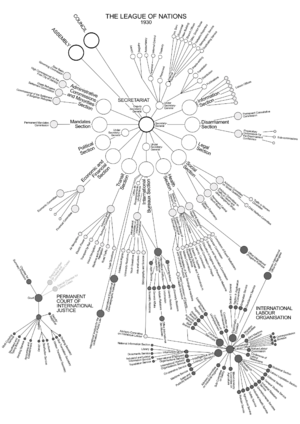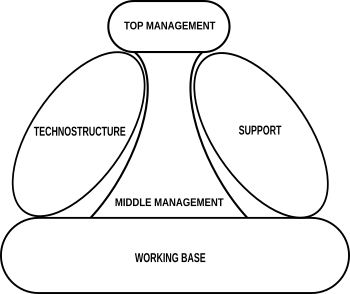Organizational structure facts for kids
An organizational structure is like a blueprint for a company or group. It shows how different tasks are shared, how people work together, and who is in charge. This structure helps everyone know their role and how their work helps the group reach its goals.
Every organization, big or small, has a structure. It helps decide who makes decisions and how things get done. A good structure helps a group work well, be flexible, and come up with new ideas. It makes sure everyone knows their responsibilities, whether they are part of a branch, department, workgroup, or just an individual.
Contents
- What are the Main Types of Structures?
- How Structures Have Changed Over Time
- Military Command and Control
- Formal and Informal Structures
- Mintzberg's Ideas on Organization Structures
- See also
What are the Main Types of Structures?
Organizations can be set up in many ways. The best way depends on what the group wants to achieve. Here are some common types of organizational structures:
Simple Structures (Pre-bureaucratic)
Simple structures are often found in small, new companies. They don't have many rules or set ways of doing things. Usually, one main leader makes all the important decisions. Most communication happens directly, face-to-face. This type of structure is great for new businesses because the founder can easily guide its growth. It works best for simple tasks, like selling products.
Bureaucratic Structures

Bureaucratic structures have more rules and set ways of working. They are common in larger organizations. Imagine a tall building with many floors; that's like a bureaucratic structure with many levels of management. Decisions have to go through many layers of people.
Key features of this type of structure include:
- Clear roles and responsibilities for everyone.
- A clear chain of command, from top leaders to lower managers.
- Decisions based on skills and fairness.
While top managers have a lot of control, this structure can make it hard for a company to change quickly. It might also discourage new ideas from employees.
Modern Structures (Post-bureaucratic)
Since the 1980s, new ideas about organization have appeared. These "post-bureaucratic" ideas try to be more flexible than traditional bureaucracies. They might use things like total quality management or matrix management.
Some thinkers imagine an organization where decisions are made by talking and agreeing, not just by orders from above. In these groups, the organization is more like a network than a ladder. This style is often used in housing cooperatives or non-profit groups to help everyone feel involved.
Functional Structure
In a functional structure, people are grouped by their skills or job. For example, a company might have departments for production, marketing, human resources, and accounting.
This setup helps employees become experts in their area. However, it can make communication between different departments difficult. Information might not flow easily across the company. This can make the organization slow to react to changes.
Functional structures are good for companies that make a lot of the same product at a low cost. But sometimes, departments might not work well together, causing delays or arguments.
Divisional Structure
A divisional structure divides a company into smaller, self-contained units. Each division acts almost like its own small business. Divisions can be based on:
- Region: Like a "U.S. Division" and an "EU Division."
- Customer Type: A division for businesses and one for households.
- Product Type: A division for trucks, another for SUVs, and another for cars.
Each division might have its own marketing, sales, and engineering teams. This structure allows managers to make decisions faster within their division. It also makes it easier to add or remove parts of the business.
However, divisions might compete with each other, which can be unhealthy. It can also cost more because each division needs its own managers and resources.
Matrix Structure
The matrix structure groups employees in two ways at the same time: by their function (like sales or accounting) and by the product or project they work on. For example, a salesperson might report to both the head of sales and the manager of "Product A."
This structure often uses teams to get work done. It tries to combine the good parts of functional and divisional structures.
There are different types of matrix structures:
- Weak Matrix: The project manager has limited power.
- Balanced Matrix: Power is shared equally between project and functional managers. This can be tricky to manage.
- Strong Matrix: The project manager has most of the power.
Matrix structures can be confusing because employees might have two bosses. This can lead to conflicts. But they can also help information spread faster across different teams and allow specialists to work on different projects. Starbucks uses a matrix structure to support its business strategy.
Team Structure
A team structure organizes work around teams. In small businesses, the whole company might be made of teams. Teams can be horizontal (across different functions) or vertical (within one function).
For example, each Whole Foods Market store is made up of about 10 self-managed teams. Even large companies like Xerox and Motorola use teams for many tasks.
While teams can be very flexible, it can sometimes be hard for different teams to communicate and share information. But focusing on teamwork and good connections can solve this.
Network Structure
A network structure is very modern. It's like a web of connected teams or even different companies working together. There's no strict hierarchy or "boss" at the top. Instead, people and groups work together on projects, and their influence changes depending on the project.
For example, H&M doesn't own factories. It works with a network of 700 suppliers around the world. This allows H&M to be very flexible and keep costs low. In a network, managers spend a lot of time coordinating with outside groups, often using technology.
This structure relies on trust between everyone involved. If trust breaks down, it can cause problems. It also needs good supervision to make sure everyone is doing their part.
Virtual Structure
A virtual organization doesn't have a physical office in the traditional sense. It uses the internet and technology to connect people and partners from all over the world. The main company might be small, but it can operate globally.
Think of Amazon.com. It can sell a huge variety of niche products online without needing massive physical stores. This structure allows companies to reach customers and suppliers easily, no matter where they are.
Hierarchy-Community Model
In the 21st century, many organizations are not purely hierarchical (like a ladder). They also have a "community" side. This means that besides their formal job roles, employees also form social connections and feel a sense of belonging.
This model suggests that an organization's structure is a mix of its formal hierarchy (who reports to whom) and its informal community (how people interact and influence each other). Just like a living thing has observable traits (phenotype) from its genes and environment, an organization's structure comes from how its employees participate both formally and informally.
Open Value Network (OVN)
An Open Value Network (OVN) is a modern, open network that uses technology a lot. Unlike some networks, there's no central power controlling everything. Examples include Bitcoin and Ethereum.
Anyone can join an OVN without a job interview or contract. These groups stay together because people are rewarded for their contributions and good work.
Decentralized Autonomous Organizations (DAOs)
DAOs are a special type of OVN. Most of their rules are written into computer code called "smart contracts." These rules run the organization automatically, with very little human involvement. The DAO was an early example.
Some believe DAOs could replace traditional management, making companies more efficient and reducing costs for managing and communicating.
How Structures Have Changed Over Time
Organizational structures have changed a lot throughout history. They started with simple tribal groups, then moved to powerful royal and religious structures, then industrial factories, and now to modern, flexible setups.
Early thinkers believed that leaders could choose any structure they wanted to make a company work well. But later, in the 1960s, some thought that the structure was more a result of outside forces. Today, many believe that the structure comes from the choices of managers and workers, influenced by their environment and how power is shared.
Military Command and Control
The way military groups are organized for Command and Control (C2) is similar to business structures. A very centralized military command is like a bureaucratic structure, with clear orders and limited information sharing. A more networked military approach, where individuals have more freedom, is like a modern, flexible structure.
Formal and Informal Structures
Sometimes, the official organizational chart doesn't show how things really work. The "informal organization" is about the social interactions and relationships that naturally form among people at work.
If the official structure doesn't match how people actually work, it can slow things down. A good organizational structure should be flexible and help people work together efficiently.
Mintzberg's Ideas on Organization Structures
Henry Mintzberg, a famous expert, described organizations in terms of their parts and how they coordinate.
Parts of an Organization
Mintzberg identified five main parts:
- Strategic apex: The top leaders of the organization.
- Middle line: Managers who connect the top leaders to the workers.
- Operating core: The workers who directly make products or provide services.
- Technostructure: Analysts who design the work processes and rules.
- Support staff: People who help other parts of the organization do their jobs (e.g., HR, IT).
He also added "organizational ideology" (the shared beliefs and values) as an important element.
How Work is Coordinated
Mintzberg listed six ways organizations coordinate work:
- Mutual adjustment: People talk and adjust their work informally.
- Direct supervision: One person tells others what to do.
- Standardization of work processes: Rules and procedures guide the work.
- Standardization of outputs: Only the final results are controlled.
- Standardization of skills: People are trained outside the organization (e.g., at a university).
- Standardization of norms: Shared values and beliefs guide behavior.
Types of Organizations (Mintzberg's Configurations)
Mintzberg combined these parts and coordination methods into seven main types of organizational structures:
- Entrepreneurial Organization: Simple and informal, with the leader making most decisions. Good for small, flexible companies.
- Machine Organization: Has many formal rules and a clear hierarchy. Common where work is simple and repetitive, like in a factory or some government offices.
- Professional Organization: Relies on highly trained professionals (like in hospitals or law firms) who have a lot of freedom in their work.
- Diversified Organization: Made of several parts that have a lot of independence. Common in large, old companies.
- Innovative Organization (Adhocracy): Brings together specialists in teams to solve new problems. Good for complex and changing environments, like an advertising agency.
- Missionary Organization: Coordinated by shared values and beliefs. Rules are few, and differences between levels are small.
- Political Organization: Power is mostly gained through workplace politics and influence, not formal rules.
See also
 In Spanish: Estructura organizacional para niños
In Spanish: Estructura organizacional para niños
- Corporate governance
- Corporation
- Industrial and organizational psychology
- Dynamic governance
- Management
- Organizational architecture
- Organizational behavior
- Organizational learning
- Organizational culture
- Organization development
- Organizational psychology
- Parent company
- Value network
- Viable system theory
- Organizational Cybernetics
- Connectivity Integrator


